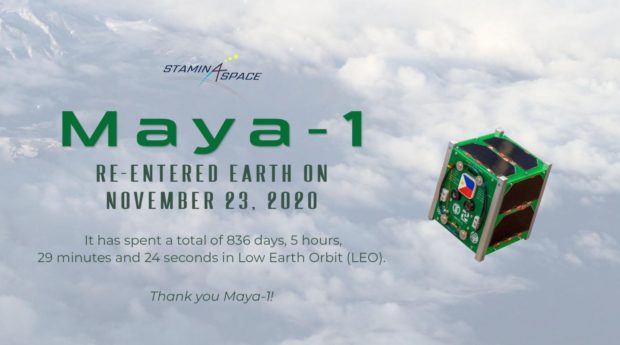First nanosatellite made by Filipinos returns from space after 2 years

First Philippine-made nanosatellite Maya-1. Image: STAMINA4Space
The eagle — or rather, the maya — has landed.
Maya-1, the first nanosatellite of the Philippines, came back from space on Nov. 23 after two years orbiting the Earth, according to a statement on Friday, Nov. 27, from the Stamina4Space program, which is funded by the Department of Science and Technology (DOST).
The cube satellite lasted 836 days, 5 hours, 29 minutes and 24 seconds in Low Earth Orbit.
Making the achievement even more remarkable is that it was only expected to stay in orbit for less than a year, said graduate student Adrian Salces, who helped develop Maya-1.
Salces developed Maya-1 with fellow graduate student Joven Javier under a research program called the Development of Scientific Earth Observation Microsatellite (PHL-Microsat) program. It is implemented by the University of the Philippines-Diliman and DOST’s Advanced Science and Technology Institute in partnership with Japan’s Kyushu Institute of Technology.

(L-R) Adrian Salces, Dr. Joel Joseph Marciano Jr, and Joven Javier. Javier and Salces developed Maya-1 in Japan, whereas Dr. Marciano is the program leader of PHL-Microsat.
Maya-1, named after the maya bird (Chestnut munia), was sent to space on the SpaceX Falcon 9 Rocket last June 29, 2018. The rocket launched from the Kennedy Space Center in Florida.
The cube, weighing at just over a kilo, is equipped with handy scientific instruments, such as two cameras that can take photos of the Earth. One of its missions was a store-and-forward system, where it would collect data from ground sensor terminals in its footprint. It would save the data and forward it to a member ground station. It also has a GPS and a magnetometer, which measures the magnetic field in space.
The development of Maya-1 has paved the way for more CubeSats — Maya-5 and Maya-6 are already in the making. Maya-2 was turned over to the Japan Aerospace Exploration Agency last September.
Philippine Space Agency director-general Joel Joseph Marciano, Jr. hopes that eventually high school students will be able to build these nanosatellites, which are a cost-effective way to do space research in the country.
The first Philippine-made satellite, Diwata-1, was sent to space in March 2016 and returned to Earth in April 2020. JB
Disclaimer: The comments uploaded on this site do not necessarily represent or reflect the views of management and owner of Cebudailynews. We reserve the right to exclude comments that we deem to be inconsistent with our editorial standards.
